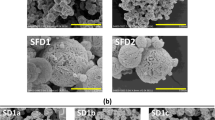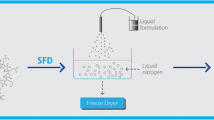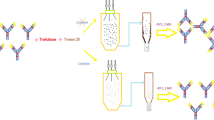Abstract
Purpose. To study the effect of trehalose, lactose, and mannitol on the biochemical stability and aerosol performance of spray-dried powders of an anti-IgE humanized monoclonal antibody.
Methods. Protein aggregation of spray-dried powders stored at various temperature and relative humidity conditions was assayed by size exclusion chromatography and sodium dodecyl sulfate polyacrylamide gel electrophoresis. Protein glycation was determined by isoelectric focusing and affinity chromatography. Crystallization was examined by X-ray powder diffraction. Aerosol performance was assessed as the fine particle fraction (FPF) of the powders blended with coarse carrier lactose, and was determined using a multiple stage liquid impinger.
Results. Soluble protein aggregation consisting of non-covalent and disulfide-linked covalent dimers and trimers occurred during storage. Aggregate was minimized by formulation with trehalose at or above a molar ratio in the range of 300:1 to 500:1 (excipient:protein). However, the powders were excessively cohesive and unsuitable for aerosol administration. Lactose had a similar stabilizing effect, and the powders exhibited acceptable aerosol performance, but protein glycation was observed during storage. The addition of mannitol also reduced aggregation, while maintaining the FPF, but only up to a molar ratio of 200:1. Further increased mannitol resulted in crystallization, which had a detrimental effect on protein stability and aerosol performance.
Conclusions. Protein stability was improved by formulation with carbohydrate. However, a balance must be achieved between the addition of enough stabilizer to improve protein biochemical stability without compromising blended powder aerosol performance.
Similar content being viewed by others
REFERENCES
L. G. Presta, S. J. Lahr, R. L. Schields, J. P. Porter, C. M. Gorman, B. M. Fendly, and P. M. Jardieu. Humanization of an antibody directed against IgE. J. Immunol. 151:2623-2632 (1993).
J. Liu, P. Lester, S. Builder, and S. J. Shire. Characterization of complex formation by humanized anti-IgE monoclonal antibody and monoclonal human IgE. Biochemistry 34:10474-10482 (1995).
J. V. Fahy, H. E. Fleming, H. H. Wong, J. T. Liu, J. Q. Su, J. Reimann, R. B. Fick Jr., and D. W. Cockcroft. The effect of an anti-IgE monoclonal antibody on the early-and late-phase responses to allergen inhalation in asthmatic subjects. Am. J. Resp. Critical Care Med. 155:1828-1834 (1997).
L. P. Boulet, K. R. Chapman, J. Cote, S. Kalra, R. Bhagat, V. A. Swystun, M. Laviolette, L. D. Cleland, F. Deschesnes, J. Q. Su, A. DeVault, R. B. Fick Jr., and D. W. Cockcroft. Inhibitory effects of an anti-IgE antibody E25 on allergen-induced early asthmatic response. Am. J. Resp. Critical Care Med. 155:1835-1840 (1997).
R. W. Niven. Delivery of biotherapeutics by inhalation aerosols. Pharm. Technol. 17(7):72-82 (1993).
J. Broadhead, S. K. Rouan Edmond, and C. T. Rhodes. The spray drying of pharmaceuticals. Drug Dev. Ind. Pharm. 18:1169-1206 (1992).
J. Broadhead, S. K. Rouan Edmond, I. Hau, and C. T. Rhodes. The effect of process and formulation variables on the properties of spray-dried β-galactosidase. J. Pharm. Pharmacol. 46:458-467 (1994).
M. Mumenthaler, C. C. Hsu, and R. Pearlman. Feasibility study on spray-drying protein pharmaceuticals. Recombinant human growth hormone and tissue-type plasminogen activator. Pharm. Res. 11:12-20 (1994).
H-K. Chan, A. R. Clark, I. Gonda, M. Mumenthaler, and C. C. Hsu. Spray-dried powders and powder blends of recombinant human deoxyribonuclease (rhDNase) for aerosol delivery. Pharm. Res. 14:431-437 (1997).
Y-F. Maa, H. R. Costantino, P-A. Nguyen, and C. C. Hsu. The effect of operating and formulation variables on the morphology of spray-dried protein particles. Pharm. Dev. Technol. 2:213-223 (1997).
J. L. Cleland, M. F. Powell, and S. J. Shire. The development of stable protein formulations. A close look at protein aggregation, deamidation, and oxidation. Critical Rev. Ther. Drug Carrier Sys. 10:307-377 (1993).
A. R. Clark, N. Dasovich, I. Gonda, and H-K. Chan. The balance between biochemical and physical stability for inhalation protein powders. rhDNase as an example. In R. N Darby, P. R. Byron, and S. J. Farr (eds.), Respiratory Drug Delivery V, Interpharm Press, Buffalo Grove, 1996, pp. 167-174.
J. F. Young. Humidity control in the laboratory using salt solutions. A review. J. Appl. Chem. 17:241-245 (1967).
R. A. Gray, A. Stern, T. A. Bewley, D. McRorie, P. Voelker, J. Liu, and S. J. Shire. Determination of protein concentration by improved optical methods. Pharm. Res. 11:76 (1994).
J. Liu, J. Ruppel, and S. J. Shire. Interaction of human IgE with soluble forms of IgE high affinity receptors. Pharm. Res. 14:1388-1393 (1997).
Y-F. Maa, P-A. Nguyen, J. D. Andya, N. Dasovich, S. J. Shire, and C. C. Hsu. Effect of spray drying and subsequent processing on residual moisture content and physical/biochemical stability of protein inhalation powders. Pharm. Res. 15:768-775 (1998).
A. Saleki-Gerhardt and G. Zografi. Non-isothermal and isothermal crystallization of sucrose from the amorphous state. Pharm. Res. 11:1166-1173 (1994).
L. M. Crowe, D. S. Reid, and J. H. Crowe. Is trehalose special for preserving dry biomaterials? Biophysical J. 71:2087-2093 (1996).
F. Franks, B. Aldous, and T. Auffret. Using water-soluble glasses as a strategy for bioproduct stabilization. Gen. Eng. News 15:20 (1995).
J. F. Carpenter, M. J. Pikal, B. S. Chang, and T. W. Randolph. Rational design of stable lyophilized protein formulations. Some practical advice. Pharm. Res. 14:969-975 (1997).
D. B. Volkin and C. R. Middaugh. The effect of temperature on protein structure. In T. J. Ahern, and M. C. Manning (Eds.), Stability of Protein Pharmaceuticals, Part A Chemical and Physical Pathways of Protein Degradation, Plenum Press, New York, 1993, pp. 215-247.
H. R. Costantino, R. Langer, and A. M. Klibanov. Solid-phase aggregation of proteins under pharmaceutically relevant conditions. J. Pharm. Sci. 83:1662-1669 (1994).
M. J. Pikal. Freeze-drying of proteins. Process, formulation, and stability. In J. L. Cleland, and R. Langer (Eds.), Formulation and Delivery of Proteins and Peptides. American Chemical Society, Washington, DC, 1994, pp. 120-133.
L. N. Bell, M. J. Hageman, and L. M. Muraoka. Thermally induced denaturation of lyophilized bovine somatotropin and lysozyme as impacted by moisture and excipients. J. Pharm. Sci. 84:707-712 (1995).
H. R. Costantino, K. G. Carrasquillo, R. A. Cordero, M. Mumenthaler, C. C. Hsu, and K. Griebenow. The effect of excipients on the stability and structure of lyophilized recombinant human growth hormone (rhGH). J. Pharm. Sci., in press, 1998.
H. R. Costantino, J. D. Andya, P-A. Nguyen, N. Dasovich, T. D. Sweeney, S. J. Shire, C. C. Hsu and Y-F. Maa. The effect of mannitol crystallization on the stability and aerosol performance of a spray-dried pharmaceutical protein, recombinant humanized anti-IgE monoclonal antibody. J. Pharm. Sci., 18:1406-1411 (1998).
J. F. Carpenter, and J. H. Crowe. An infrared spectroscopic study of the interactions of carbohydrates with dried proteins. Biochemistry 28: 3916-3922 (1989).
S. J. Prestrelski, K. A. Pikal, and T. Arakawa. Optimization of lyophilization conditions for recombinant human interleukin-2 by dried-state conformational analysis using fourier-transform infrared spectroscopy. Pharm Res. 12:1250-1259 (1995).
H. R. Costantino, J. D. Andya, S. J. Shire, and C. C. Hsu. Fouriertransform infrared spectroscopic analysis of the secondary structure of recombinant humanized immunoglobulin G. Pharm. Sci. 3:121-128 (1997).
H. R. Costantino, J. G. Curley, and C. C. Hsu. Determining the water sorption monolayer of lyophilized pharmaceutical proteins. J. Pharm. Sci. 86:1390-1393 (1997).
A. J. Furth. Methods for assaying nonenzymatic glycosylation. Anal. Biochem. 175:347-360 (1988).
F. J. Shen, J. D. Andya, S. J. Shire, and R. J. Harris. The detection of lactosylated sites. Protein Sci. 6(Suppl. 2):152 (1997).
Author information
Authors and Affiliations
Corresponding author
Rights and permissions
About this article
Cite this article
Andya, J.D., Maa, YF., Costantino, H.R. et al. The Effect of Formulation Excipients on Protein Stability and Aerosol Performance of Spray-Dried Powders of a Recombinant Humanized Anti-IgE Monoclonal Antibody1. Pharm Res 16, 350–358 (1999). https://doi.org/10.1023/A:1018805232453
Issue Date:
DOI: https://doi.org/10.1023/A:1018805232453




